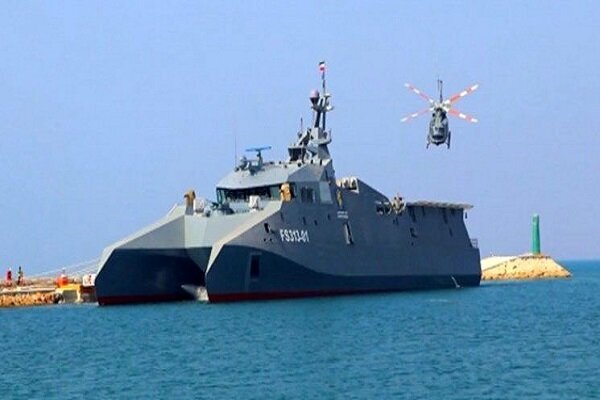Two new warships added to IRGC Navy Force

TEHRAN – At a ceremony in the southern Iranian port city of Bandar Abbas on Monday, two new warships from the Shahid Soleimani-class were unveiled.
The two catamarans, namely "Shahid Sayyad Shirazi" and "Shahid Hassan Bagheri," were delivered to the Islamic Revolution Guard Corps (IRGC) in the presence of top military officials.
The impressive ceremony in the capital of Hormozgan province was attended by Chief of Staff of the Iranian Armed Forces Major General Mohammad Bagheri, IRGC Navy commander Rear Admiral Alireza Tangsiri, and other senior military officials.
General Bagheri, in his remarks during the ceremony, proudly acknowledged the advancements in Iran's naval capabilities. He emphasized the impressive efficiency in research-to-production timelines, noting that Iran's progress is nearly unmatched compared to other nations.
Discussing the regional situation, Bagheri observed the apparent withdrawal of the U.S. invading army from the Persian Gulf, only to witness an immediate return with various excuses and in different forms.
Underlining the defensive prowess of the Islamic Republic of Iran for national security, the top general emphasized the armed forces' dedication to taking even the smallest threat seriously, ensuring a constant state of preparedness.
Touching on the Gaza situation, Bagheri portrayed it as a pivotal moment globally, signifying the undeniable and irreparable defeat of the Zionist regime. He rejected the Israeli attempts to compensate for their costly loss through the tragic killing of defenseless Gazan civilians, underscoring the two distinct fronts in the conflict – the righteous side, which includes the oppressed Palestinian people and their allies like Yemen, Hezbollah, and resistance groups in Iraq; and the opposing forces, comprising unjust Zionists, the U.S., and Europe, exposing the hypocrisy in Western discussions on human rights and democracy.
Rear Admiral Tangsiri, in his speech, provided some features about the two new warships, describing them as a domestically designed and manufactured catamarans with sophisticated radar-evading technologies.
He said both of these warships can cruise within a radius of 5,500 nautical miles (9,500 kilometers) without being detected by enemy radars and reconnaissance systems.
The two new warships are the second and third models of Soleimani-class vessels, the first of which, unveiled on January 6, has been named after Abu Mahdi al-Muhandis, an Iraqi commander of the Popular Mobilization Units (PMU) who was martyred alongside Iran’s Lt. General Qassem Soleimani in a U.S. strike in Baghdad in January 2020. Measuring 67 meters in length, 20 meters in width, and weighing 600 tons, these two IRGC warships are powered by four propulsive engines and can carry a combat helicopter and three light corvettes.
These state-of-the-art, radar-evading warships boast the advanced “Navvab” missile system which is capable of vertical launches and the “Sayyad” cruise missile, showcasing an impressive range of 700 kilometers.
The Shahid Sayyad Shirazi vessel is armed with formidable long-range defensive missiles, specifically the Sayyad and the Navvab defensive missile systems. This development underscores the continuous enhancement of Iran's naval capabilities in the region.
According to General Bagheri, the construction of these warships took place at the specialized naval center in Bushehr city.
The Shahid Soleimani class is relatively smaller in tonnage, comparable to corvettes, but has a longer range (5,000 miles) than modern destroyers and comparable firepower and air defense capabilities to frigates.
This design allows breaking the seawater during sailing more easily than a conventional catamaran, as well as more transverse stability in harsh sea states.
Although it has shipbuilding capacity for large tonnage warships, Iran has no plans for them and favors smaller vessels for global power projection.
The combination of new cruise missiles, hypersonic missiles, anti-ship quasi-ballistic missiles, naval drones and swarm drones have made today's large warships more vulnerable than ever.
Iran’s Navy has achieved self-sufficiency in manufacturing surface and sub-surface vessels in recent years. It has also increased its presence in international waters to protect naval routes and provide security for merchant vessels and tankers.
Iranian military experts and engineers have made remarkable breakthroughs in manufacturing a broad range of indigenous equipment in recent years, contributing to the armed forces' self-sufficiency.
Leave a Comment